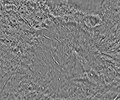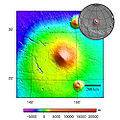Elysium (volcanic Province)
Composition
The southeastern portion of the province is geochemically distinct from the northwest. The southeast is composed of sedimentary and porous rocks. The majority of the southeastern portion is made up of Amazonian-Hesperian volcanic units. Most of the remaining southeastern volcanic units are late Amazonian in nature. In recent history, there were significant groundwater deposits in the region.
It has been hard to study the composition of this province, due to the layer of dust that sits on top of the crust. Investigations in relatively dust-free regions indicate that it is made primarily of high-calcium pyroxene and olivine. To a lesser degree, the province is made up of hematite and hydrated silica, among other things. There are no strong magnetic fields in the region. There are some extant near-surface glacial deposits in the caldera of Hecates Tholus, a volcano in the province.
Formation
The southeastern portion of the province is approximately 0.85 billion years younger than the northwestern. The region as a whole has been volcanically active for at least 3.9 billion years, with a peak 2.2 billion years ago, although activity has decreased considerably in the last billion years. Crater counting done on the lava flows in the southern region show low cratering rates, which would indicate younger volcanic activity, as recent as 10 Myr. The most recent volcanic activity dates to 2 million years ago. The southeastern portion overlaps with Cerberus Fossae; features in this region are thought to have formed due to volcanic and water-related processes, such as phreatomagmatism, relict ice flows, and interactions between lava and water. In general, many flow units in Elysium Planitia (such as Rahway Valles and Marte Vallis) are thought to have their origins in lava originating from this region.
Hecates Tholus erupted ~350 million years ago, with glacial deposits in the resulting caldera dating between 5 and 24 million years ago. Craters in the region are not generally typical of impacts; rather, they are thought to have formed due to explosive volcanism or collapse due to subsurface lava withdrawal.
Elysium contains numerous lava flow units with variable histories as well as volcanic and fluvial channels. The three major volcanoes of the region sit on top of a 1700 x 2400 km broad dome. The summit of Hecates Tholus shows evidence of pyroclastic activity. Martian volcanism has been dominated by effusive eruption styles and there is limited evidence to support widespread explosive or pyroclastic volcanic eruptions on Mars.
Elysium Mons is approximately 1.5 times as steep as any other Martian volcano at approximately 7-7.5°. The caldera at the summit of Elysium Mons is approximately 13.5 km in diameter. Extending past the rim of this central caldera are at least 18 sinuous channels thought to be the remnants of collapsed lava tubes and lava channels.
Observation history
The Elysium volcanic province was first noticed as a distinct Martian region as a result of data obtained from the Mariner 9 mission, in the 1970s. The Viking orbiter noted that volcanic province of Elysium experienced more diverse types of volcanism than the Tharsis volcanic region. In 2004, ESA's Mars Express orbiter's HRSC observed the volcanoes in the region. The InSight Lander landed just south of the province in 2018, in Elysium Planitia, and has detected marsquakes emanating from this region. The main science goals of the lander are to monitor the level of seismic activity occurring on Mars and to understand how Mars formed and how the planet has been evolving ever since.
Volcanoes of Elysium
-
High-resolution THEMIS daytime infrared image mosaic of Elysium from 2001 Mars Odyssey.
-
MOLA maps showing the geographic context of Elysium.
-
Hecates Tholus, as seen by THEMIS.
-
Albor Tholus, as seen by THEMIS.
Troughs (fossae) in Elysium
-
Troughs to the east of Albor Tholus, as seen by HiRISE under the HiWish program
-
Portion of a trough (fossa) in Elysium, as seen by HiRISE under the HiWish program (blue indicates probably seasonal frost)
-
A Cerberus Fossae trough, as seen from THEMIS
-
Wind-blown material darkens areas around a Cerberus Fossae trough (scale bar for HiRISE image is 500 m)
-
The Cerberus Fossae, as seen by HiRISE (scale bar is 1.0 km)
-
The Elysium Fossae, as seen by HiRISE (click on image to see layers)
-
Two views of the Hephaestus Fossae, as seen by HiRISE (picture on right lies to the top (north) of other picture). Fossae often form by material moving into an underground void.
See also
Notes
- ^ Officially, "Elysium" is an albedo feature.
References
- ^ "Elysium". Gazetteer of Planetary Nomenclature. USGS Astrogeology Science Center. Retrieved 2018-05-07.
- ^ Mouginis-Mark, Peter J.; Wilson, Lionel; Head, James W.; Brown, Steven H.; Lynn Hall, J.; Sullivan, Kathryn D. (1984-04-01). "Elysium planitia, mars: Regional geology, volcanology, and evidence for volcano-ground ice interactions". Earth, Moon, and Planets. 30 (2): 149–173. Bibcode:1984EM&P...30..149M. doi:10.1007/BF00114309. ISSN 1573-0794. S2CID 120632318.
- ^ "Elysium Mons Volcanic Region". NASA Jet Propulsion Laboratory (JPL). Retrieved 2021-02-26.
- ^ "Elysium Planitia". Gazetteer of Planetary Nomenclature. USGS Astrogeology Science Center. Retrieved 2018-05-07.
- ^ Susko, David; Karunatillake, Suniti; Kodikara, Gayantha; Skok, J. R.; Wray, James; Heldmann, Jennifer; Cousin, Agnes; Judice, Taylor (2017-02-24). "A record of igneous evolution in Elysium, a major martian volcanic province". Scientific Reports. 7 (1): 43177. Bibcode:2017NatSR...743177S. doi:10.1038/srep43177. ISSN 2045-2322. PMC 5324095. PMID 28233797.
- ^ Morgan, Gareth A.; Campbell, Bruce A.; Carter, Lynn M.; Plaut, Jeffrey J. (2015). "Evidence for the episodic erosion of the Medusae Fossae Formation preserved within the youngest volcanic province on Mars". Geophysical Research Letters. 42 (18): 7336–7342. Bibcode:2015GeoRL..42.7336M. doi:10.1002/2015GL065017. ISSN 1944-8007.
- ^ Burr, Devon M.; Grier, Jennifer A.; McEwen, Alfred S.; Keszthelyi, Laszlo P. (2002-09-01). "Repeated Aqueous Flooding from the Cerberus Fossae: Evidence for Very Recently Extant, Deep Groundwater on Mars". Icarus. 159 (1): 53–73. Bibcode:2002Icar..159...53B. doi:10.1006/icar.2002.6921. ISSN 0019-1035.
- ^ Viviano, Christina E.; Murchie, Scott L.; Daubar, Ingrid J.; Morgan, M. Frank; Seelos, Frank P.; Plescia, Jeffrey B. (2019-08-01). "Composition of Amazonian volcanic materials in Tharsis and Elysium, Mars, from MRO/CRISM reflectance spectra". Icarus. 328: 274–286. Bibcode:2019Icar..328..274V. doi:10.1016/j.icarus.2019.03.001. ISSN 0019-1035. S2CID 127155512.
- ^ Pan, Lu; Quantin-Nataf, Cathy; Tauzin, Benoit; Michaut, Chloé; Golombek, Matt; Lognonné, Phillipe; Grindrod, Peter; Langlais, Benoit; Gudkova, Tamara; Stepanova, Inna; Rodriguez, Sébastien; Lucas, Antoine (2020-03-01). "Crust stratigraphy and heterogeneities of the first kilometers at the dichotomy boundary in western Elysium Planitia and implications for InSight lander". Icarus. 338: 113511. Bibcode:2020Icar..33813511P. doi:10.1016/j.icarus.2019.113511. hdl:1885/222099. ISSN 0019-1035.
- ^ Hauber, Ernst; van Gasselt, Stephan; Ivanov, Boris; Werner, Stephanie; Head, James W.; Neukum, Gerhard; Jaumann, Ralf; Greeley, Ronald; Mitchell, Karl L.; Muller, Peter (March 2005). "Discovery of a flank caldera and very young glacial activity at Hecates Tholus, Mars". Nature. 434 (7031): 356–361. Bibcode:2005Natur.434..356H. doi:10.1038/nature03423. ISSN 1476-4687. PMID 15772654. S2CID 4427179.
- ^ Platz, Thomas; Michael, Gregory (2011-12-01). "Eruption history of the Elysium Volcanic Province, Mars". Earth and Planetary Science Letters. 312 (1): 140–151. Bibcode:2011E&PSL.312..140P. doi:10.1016/j.epsl.2011.10.001. ISSN 0012-821X.
- ^ Hartmann, William K.; Berman, Daniel C. (2000). "Elysium Planitia lava flows: Crater count chronology and geological implications". Journal of Geophysical Research: Planets. 105 (E6): 15011–15025. Bibcode:2000JGR...10515011H. doi:10.1029/1999JE001189. ISSN 2156-2202.
- ^ Voigt, Joana R. C.; Hamilton, Christopher W. (2018-07-15). "Investigating the volcanic versus aqueous origin of the surficial deposits in Eastern Elysium Planitia, Mars". Icarus. 309: 389–410. Bibcode:2018Icar..309..389V. doi:10.1016/j.icarus.2018.03.009. ISSN 0019-1035. S2CID 125918565.
- ^ Mouginis-Mark, Peter J.; Wilson, Lionel; Head, James W.; Brown, Steven H.; Lynn Hall, J.; Sullivan, Kathryn D. (1984-04-01). "Elysium planitia, mars: Regional geology, volcanology, and evidence for volcano-ground ice interactions". Earth, Moon, and Planets. 30 (2): 149–173. Bibcode:1984EM&P...30..149M. doi:10.1007/BF00114309. ISSN 1573-0794. S2CID 120632318.
- ^ Whelley, Patrick; Novak, Alexandra Matiella; Richardson, Jacob; Bleacher, Jacob; Mach, Kelsey; Smith, Reagan N. (2021). "Stratigraphic Evidence for Early Martian Explosive Volcanism in Arabia Terra". Geophysical Research Letters. 48 (15): e2021GL094109. Bibcode:2021GeoRL..4894109W. doi:10.1029/2021GL094109. ISSN 1944-8007. S2CID 237689743.
- ^ Wilson, Lionel; Mouginis-Mark, Peter J. (2001). "Estimation of volcanic eruption conditions for a large flank event on Elysium Mons, Mars". Journal of Geophysical Research: Planets. 106 (E9): 20621–20628. Bibcode:2001JGR...10620621W. doi:10.1029/2000JE001420. ISSN 2156-2202.
- ^ Kallianpur, K.; Mouginis-Mark, P. J. (2001-03-01). "Slopes of Martian Volcanoes". Lunar and Planetary Science Conference: 1258. Bibcode:2001LPI....32.1258K.
- ^ Blasius, Karl R.; Cutts, James A. (1981-01-01). "Topography of Martian central volcanoes". Icarus. 45 (1): 87–112. Bibcode:1981Icar...45...87B. doi:10.1016/0019-1035(81)90008-7. ISSN 0019-1035.
- ^ Williams, David A.; Greeley, Ronald; Manfredi, Leon; Raitala, Jouko; Neukum, Gerhard (2010-06-01). "The Circum-Hellas Volcanic Province, Mars: Assessment of wrinkle-ridged plains". Earth and Planetary Science Letters. Mars Express after 6 Years in Orbit: Mars Geology from Three-Dimensional Mapping by the High Resolution Stereo Camera (HRSC) Experiment. 294 (3): 492–505. Bibcode:2010E&PSL.294..492W. doi:10.1016/j.epsl.2009.10.007. ISSN 0012-821X.
- ^ McCauley, J. F.; Carr, M. H.; Cutts, J. A.; Hartmann, W. K.; Masursky, Harold; Milton, D. J.; Sharp, R. P.; Wilhelms, D. E. (1972-10-01). "Preliminary mariner 9 report on the geology of Mars". Icarus. 17 (2): 289–327. doi:10.1016/0019-1035(72)90003-6. ISSN 0019-1035.
- ^ Mouginis-Mark, Peter J.; Wilson, Lionel; Head, James W.; Brown, Steven H.; Lynn Hall, J.; Sullivan, Kathryn D. (1984-04-01). "Elysium planitia, mars: Regional geology, volcanology, and evidence for volcano-ground ice interactions". Earth, Moon, and Planets. 30 (2): 149–173. Bibcode:1984EM&P...30..149M. doi:10.1007/BF00114309. ISSN 1573-0794. S2CID 120632318.
- ^ "HRSC Bildserie #011 - Albor Tholus (Mars Express Orbit 0032); Fachrichtung Planetologie und Fernerkundung an der FU Berlin". www.planet.geo.fu-berlin.de. Retrieved 2021-02-26.
- ^ Horvath, David G.; Moitra, Pranabendu; Hamilton, Christopher W.; Craddock, Robert A.; Andrews-Hanna, Jeffrey C. (2021). "Evidence for geologically recent explosive volcanism in Elysium Planitia, Mars". Icarus. 365: 114499. arXiv:2011.05956. Bibcode:2021Icar..36514499H. doi:10.1016/j.icarus.2021.114499. S2CID 226299879.
- ^ Lognonné, P.; Banerdt, W. B.; Giardini, D.; Pike, W. T.; Christensen, U.; Laudet, P.; de Raucourt, S.; Zweifel, P.; Calcutt, S.; Bierwirth, M.; Hurst, K. J. (2019-01-28). "SEIS: Insight's Seismic Experiment for Internal Structure of Mars". Space Science Reviews. 215 (1): 12. Bibcode:2019SSRv..215...12L. doi:10.1007/s11214-018-0574-6. ISSN 1572-9672. PMC 6394762. PMID 30880848.
- ^ mars.nasa.gov. "Quick Facts | Mission". NASA's InSight Mars Lander. Retrieved 2021-11-10.
- ^ mars.nasa.gov. "InSight Mission Overview". NASA's InSight Mars Lander. Retrieved 2021-11-10.
- ^ Banerdt, W. Bruce; Smrekar, Suzanne E.; Banfield, Don; Giardini, Domenico; Golombek, Matthew; Johnson, Catherine L.; Lognonné, Philippe; Spiga, Aymeric; Spohn, Tilman; Perrin, Clément; Stähler, Simon C. (2020). "Initial results from the InSight mission on Mars". Nature Geoscience. 13 (3): 183–189. Bibcode:2020NatGe..13..183B. doi:10.1038/s41561-020-0544-y. ISSN 1752-0908. S2CID 211266334.
External links
- Google Mars - zoomable map centered on Elysium Planitia, with three main volcanoes of Elysium visible
- google mars - Cerebrus Fossae fissures










